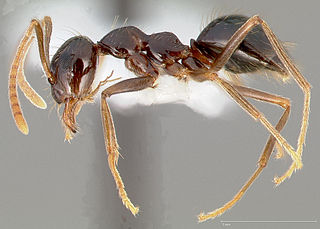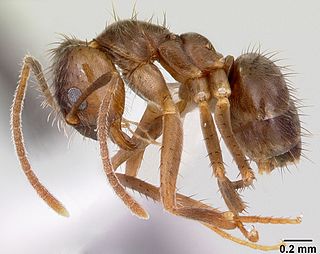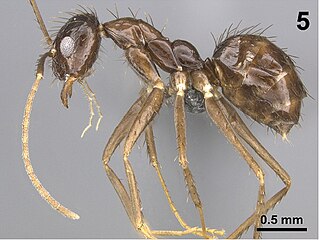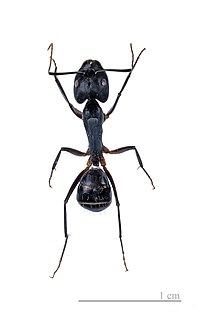
Plagiolepidini are an ant tribe from the subfamily Formicinae.

Paratrechina is one of seven ant genera in the Prenolepis genus-group from the subfamily Formicinae. Six species are included in Paratrechina; one of which, the longhorn crazy ant, is a widespread, pantropical pest.
Barry Bolton is an English myrmecologist, an expert on the classification, systematics, and taxonomy of ants, who long worked at the Natural History Museum (London). He is known especially for monographs on African and Asian ants and for three encyclopaedic global works, including the Identification Guide to Ant Genera (1994), a full catalogue of ant taxa, and a synopsis and classification (2003). Now retired, Bolton is a Fellow of the Royal Entomological Society and Myrmecologist, Biodiversity Division, Department of Entomology, Natural History Museum, London.
Fulvous is a colour, sometimes described as dull orange, brownish-yellow or tawny, it can also be likened to a variation of buff, beige or butterscotch. As an adjective it is used in the names of many species of birds, and occasionally other animals, to describe their appearance. It is also used as in mycology to describe fungi with greater colour specificity, specifically the pigmentation of the surface cuticle, the broken flesh and the spores en masse.

The Rasberry crazy ant or tawny crazy ant, Nylanderia fulva, is an ant originating from South America. Like the longhorn crazy ant, this species is called "crazy ant" because of its quick, unpredictable movements. It is called the "Rasberry crazy ant" in Texas after the exterminator Tom Rasberry, who noticed that the ants were increasing in numbers in 2002. Scientists have reorganised the genera taxonomy within this clade of ants, and now it is identified as Nylanderia fulva.

Nylanderia pubens is a species of ant of the genus Nylanderia, commonly called the Caribbean crazy ant. It was originally described as Paratrechina pubens from Saint Vincent, Lesser Antilles. This species was moved from Paratrechina to the genus Nylanderia in 2010.

Nylanderia is a large genus of ants in the subfamily Formicinae. The genus has a nearly cosmopolitan distribution with species inhabiting a wide array of habitats in almost all geographic regions. Nylanderia, currently containing over 110 species, is an ecologically important genus, with some species reported as being invasive. The ants are small to medium in size and range in color from pale yellow to black.

Paratrechina zanjensis is an African species of ant in the genus Paratrechina. It is one of two species in the genus, the other being the longhorn crazy ant.
Nylanderia taylori is a species of Formicinae ant found in Bangladesh, India and Sri Lanka.
Nylanderia vagabunda, is a species of Formicinae ant found in Sri Lanka.
Polyrhachis yerburyi is a species of ant in the subfamily Formicinae, found in Sri Lanka.
Pheidole spathifera is a species of ant in the subfamily Myrmicinae. It is found in Asian countries.
Tetramorium yerburyi is a species of ant in the subfamily Myrmicinae. It is found in Sri Lanka and China.
Anochetus yerburyi is a species of ant of the subfamily Ponerinae. It can be found in India and Sri Lanka.
Leptogenys yerburyi is a species of ant of the subfamily Ponerinae. It is found in Sri Lanka, and China.

Nylanderia pygmaea is an extinct species of formicid in the ant subfamily Formicinae known from fossils found in the Baltic region.

Lasiini is a tribe of ants in the family Formicidae. There are about 10 genera and more than 450 described species in Lasiini.
This page is based on this
Wikipedia article Text is available under the
CC BY-SA 4.0 license; additional terms may apply.
Images, videos and audio are available under their respective licenses.









